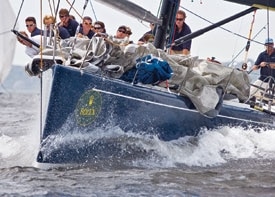
BlueYankeeStory
When Reichel/Pugh Yacht Design was asked to design a new 66-foot Blue Yankee for Bob Towse, of New York, N.Y., they jumped on it. After a four-month build in Argentina, the carbon-fiber 66-footer was shipped to the United States for the first races of the Onion Patch Series/New York YC Annual Regatta in early June. With its low freeboard, and narrow hull painted in Towse’s trademark dark blue, Blue Yankee showed what it was made of, scoring a 3,1,1,1 for the series (under IRC) and taking first place over the canting-keel R/P 66 Stark Raving Mad, and the 75-foot R/P Titan XII.”Because of the nature of the concept, and the performance characteristics of the boat as a very good offshore boat, it will do well buoy racing,” says Jim Pugh. “The boat isn’t fine-tuned to IRC, but it doesn’t pick up any major penalties. Because Blue Yankee wasn’t designed to any handicap or box rule, we were creating a box of our own. The characteristics of the beam-to-length, and all the general parameters, allowed us to create a powerful boat with a high prismatic. It doesn’t have much wetted surface so you get performance across the range.” On deck, twin wheels set relatively far forward give the helmsman good visibility and keep weight out of the stern. A small, narrow deckhouse allows for jib inhaulers, perfect for power reaching. “With that hull shape, as soon as you head off even slightly, the speeds start going up,” says Pugh. “The boat has very good upwind performance, but as soon as you crack off even a little bit, it’s just gone.” Towse does a lot of the navigation and leaves the driving to others. His nav station is directly under the mainsheet winches, and like many of Towse’s boats, has a hatch overhead, which allows him to communicate with the watch on deck. The interior is painted white, rather than clear-coated carbon, and boasts a two-burner stove, a head, and pipe berths. The rig uses Southern Spars’ Element C6 carbon-fiber rigging, which is continuous and has no terminations. “We wanted a simple rig,” says Pugh. “It’s pretty straightforward, but it takes a while to tune it properly because you’ve got very few adjust ments-no runners, no checks, no headstay cylinders.” Permanently rigged jockey poles and a long spinnaker pole attached to a single gooseneck on the rig, control large asymmetric spinnakers.









